BUICK RAINIER 2004 Service Manual
Manufacturer: BUICK, Model Year: 2004, Model line: RAINIER, Model: BUICK RAINIER 2004Pages: 452, PDF Size: 4.51 MB
Page 41 of 452
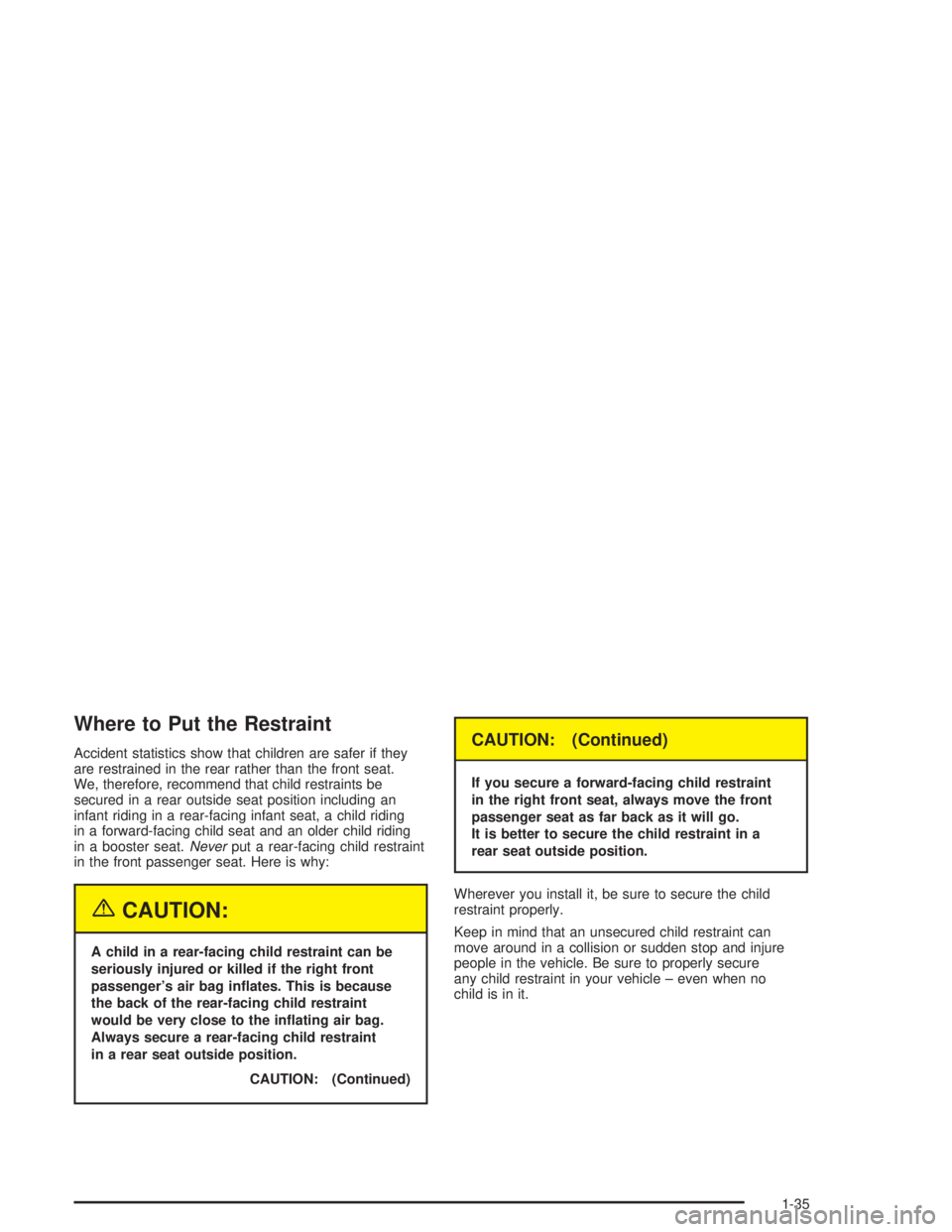
Where to Put the Restraint
Accident statistics show that children are safer if they
are restrained in the rear rather than the front seat.
We, therefore, recommend that child restraints be
secured in a rear outside seat position including an
infant riding in a rear-facing infant seat, a child riding
in a forward-facing child seat and an older child riding
in a booster seat.Neverput a rear-facing child restraint
in the front passenger seat. Here is why:
{CAUTION:
A child in a rear-facing child restraint can be
seriously injured or killed if the right front
passenger’s air bag in�ates. This is because
the back of the rear-facing child restraint
would be very close to the in�ating air bag.
Always secure a rear-facing child restraint
in a rear seat outside position.
CAUTION: (Continued)
CAUTION: (Continued)
If you secure a forward-facing child restraint
in the right front seat, always move the front
passenger seat as far back as it will go.
It is better to secure the child restraint in a
rear seat outside position.
Wherever you install it, be sure to secure the child
restraint properly.
Keep in mind that an unsecured child restraint can
move around in a collision or sudden stop and injure
people in the vehicle. Be sure to properly secure
any child restraint in your vehicle – even when no
child is in it.
1-35
Page 42 of 452
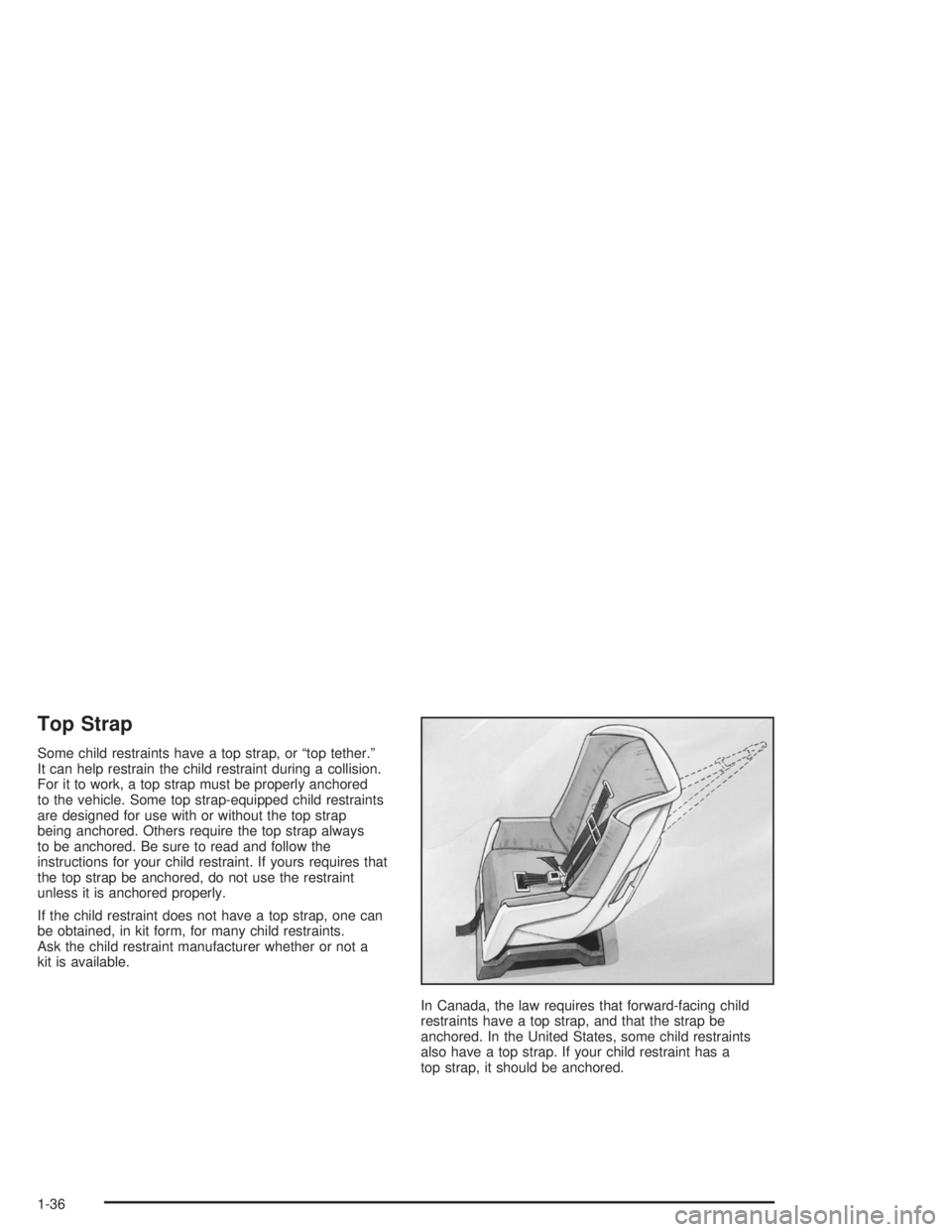
Top Strap
Some child restraints have a top strap, or “top tether.”
It can help restrain the child restraint during a collision.
For it to work, a top strap must be properly anchored
to the vehicle. Some top strap-equipped child restraints
are designed for use with or without the top strap
being anchored. Others require the top strap always
to be anchored. Be sure to read and follow the
instructions for your child restraint. If yours requires that
the top strap be anchored, do not use the restraint
unless it is anchored properly.
If the child restraint does not have a top strap, one can
be obtained, in kit form, for many child restraints.
Ask the child restraint manufacturer whether or not a
kit is available.
In Canada, the law requires that forward-facing child
restraints have a top strap, and that the strap be
anchored. In the United States, some child restraints
also have a top strap. If your child restraint has a
top strap, it should be anchored.
1-36
Page 43 of 452
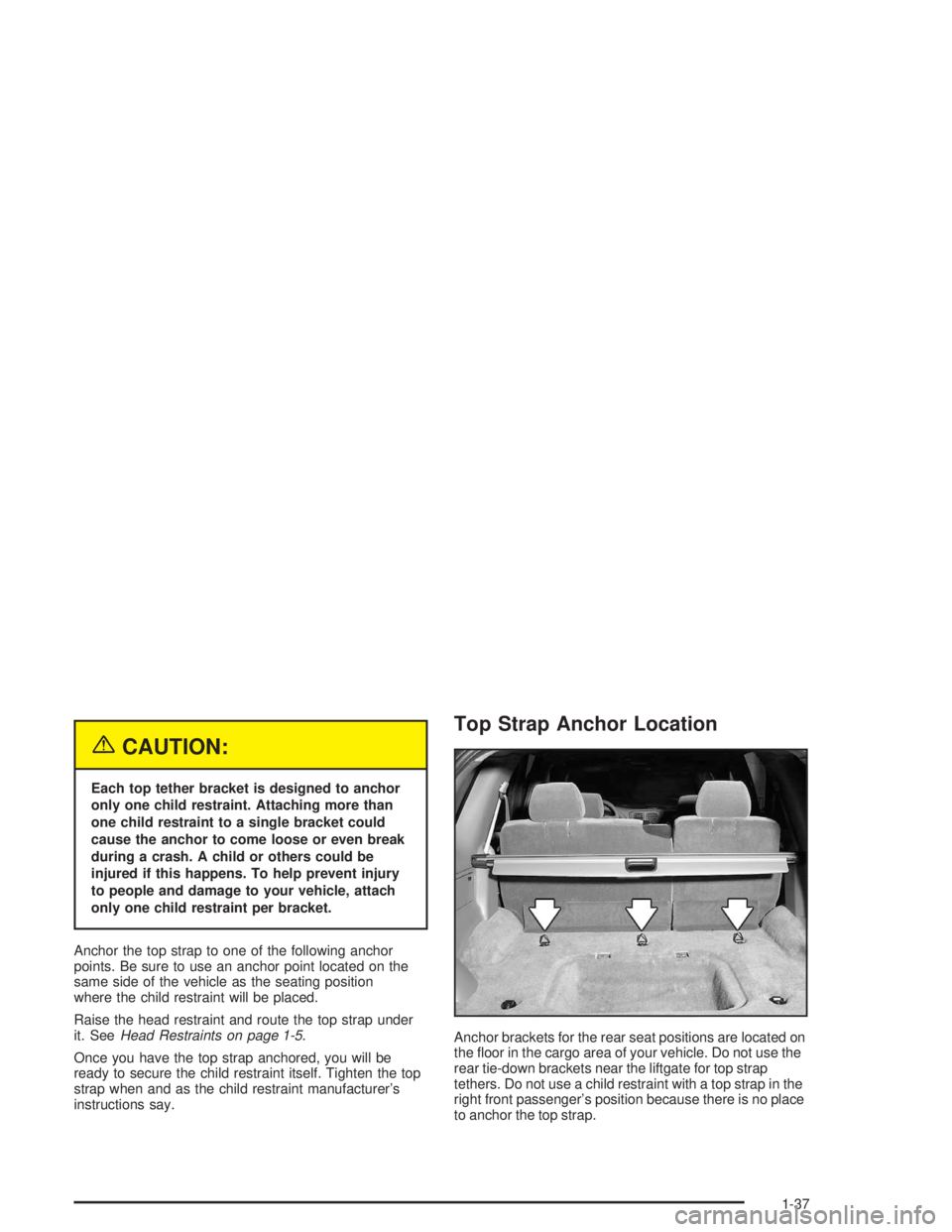
{CAUTION:
Each top tether bracket is designed to anchor
only one child restraint. Attaching more than
one child restraint to a single bracket could
cause the anchor to come loose or even break
during a crash. A child or others could be
injured if this happens. To help prevent injury
to people and damage to your vehicle, attach
only one child restraint per bracket.
Anchor the top strap to one of the following anchor
points. Be sure to use an anchor point located on the
same side of the vehicle as the seating position
where the child restraint will be placed.
Raise the head restraint and route the top strap under
it. SeeHead Restraints on page 1-5.
Once you have the top strap anchored, you will be
ready to secure the child restraint itself. Tighten the top
strap when and as the child restraint manufacturer’s
instructions say.
Top Strap Anchor Location
Anchor brackets for the rear seat positions are located on
the �oor in the cargo area of your vehicle. Do not use the
rear tie-down brackets near the liftgate for top strap
tethers. Do not use a child restraint with a top strap in the
right front passenger’s position because there is no place
to anchor the top strap.
1-37
Page 44 of 452

Lower Anchorages and Top Tethers
for Children (LATCH System)
Your vehicle has the LATCH system. You’ll �nd
anchors (A) in the rear outside seat positions.
This system, designed to make installation of child
restraints easier, does not use the vehicle’s safety belts.
Instead, it uses vehicle anchors (A,B) and child restraint
attachments to secure the restraints. Some restraints
also use another vehicle anchor to secure a top tether
strap (C).
1-38
Page 45 of 452
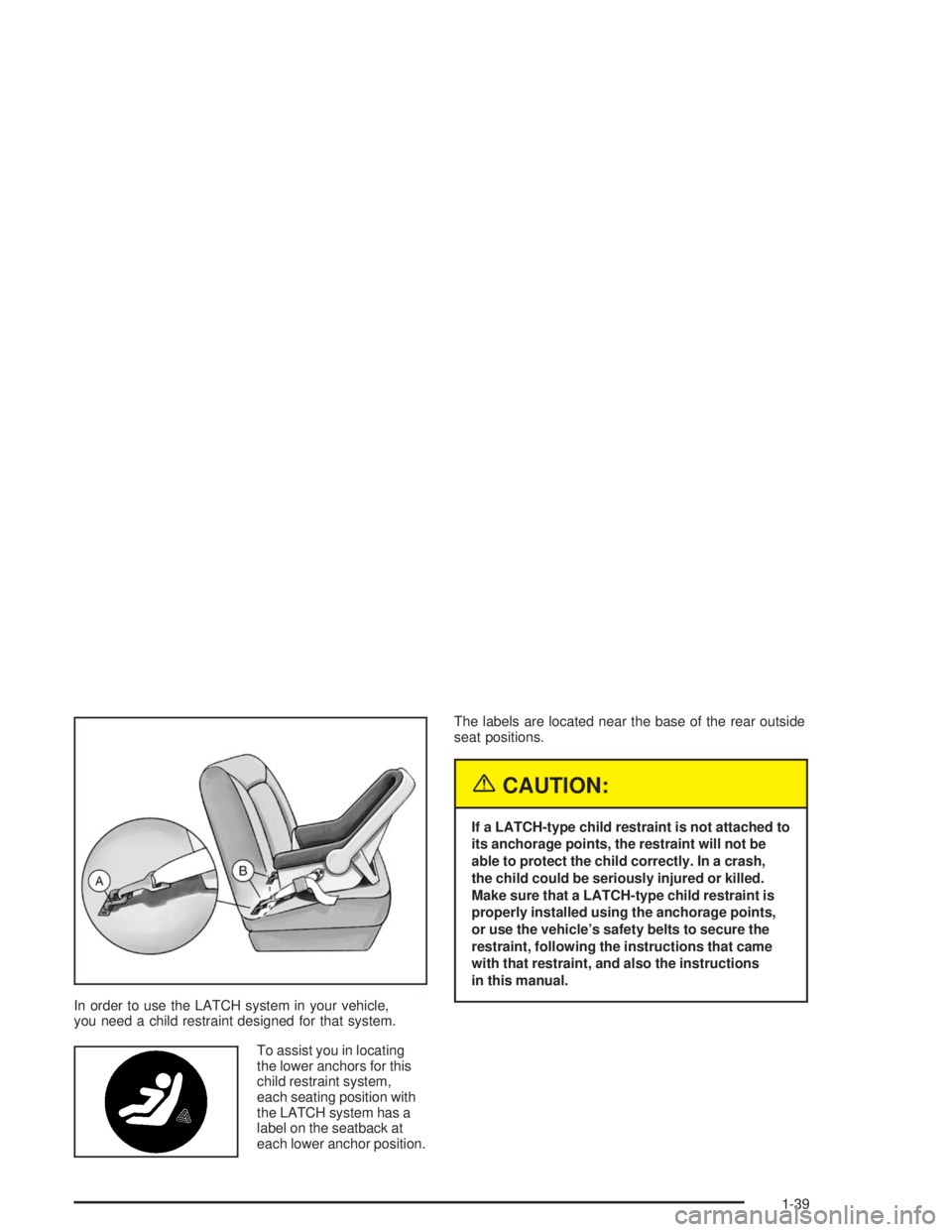
In order to use the LATCH system in your vehicle,
you need a child restraint designed for that system.
To assist you in locating
the lower anchors for this
child restraint system,
each seating position with
the LATCH system has a
label on the seatback at
each lower anchor position.The labels are located near the base of the rear outside
seat positions.
{CAUTION:
If a LATCH-type child restraint is not attached to
its anchorage points, the restraint will not be
able to protect the child correctly. In a crash,
the child could be seriously injured or killed.
Make sure that a LATCH-type child restraint is
properly installed using the anchorage points,
or use the vehicle’s safety belts to secure the
restraint, following the instructions that came
with that restraint, and also the instructions
in this manual.
1-39
Page 46 of 452
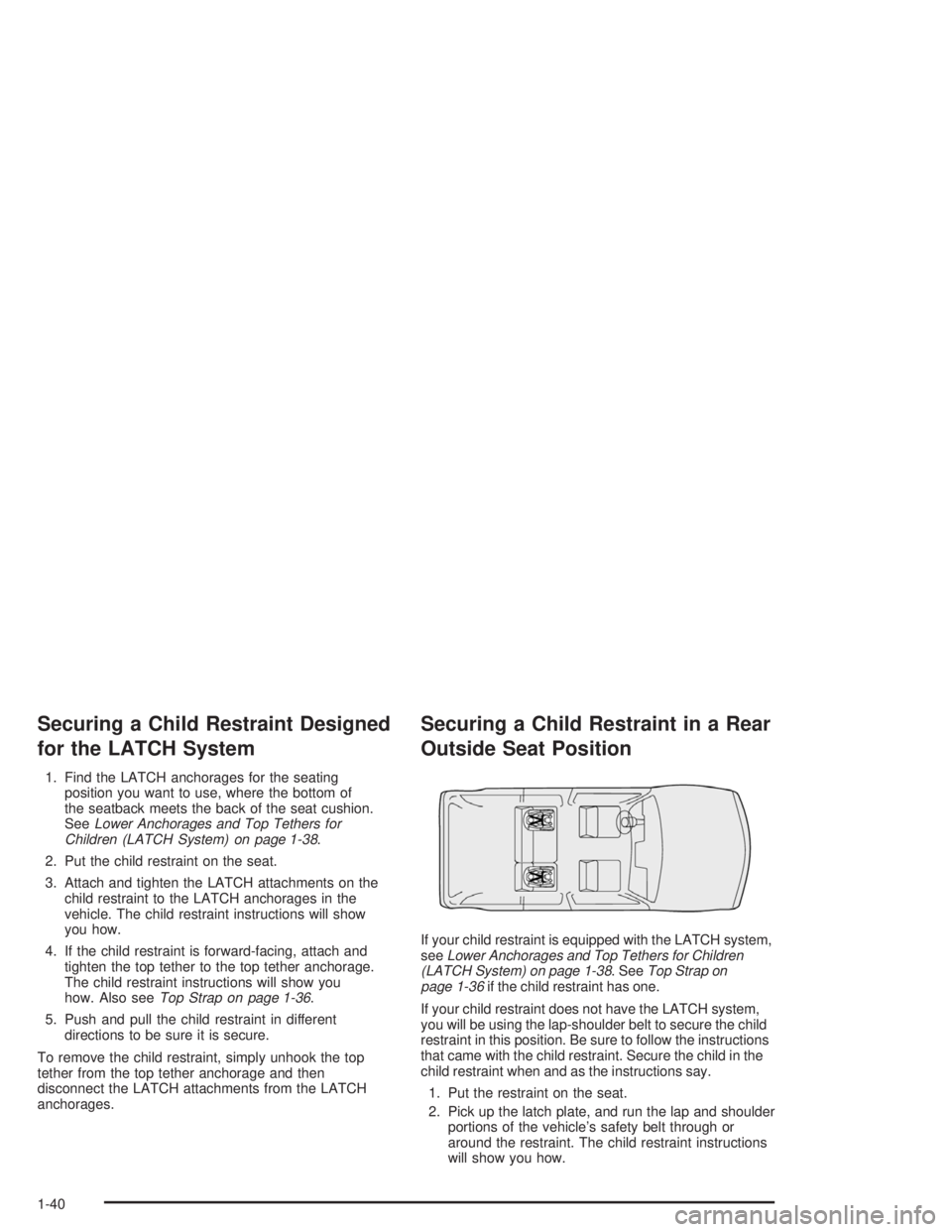
Securing a Child Restraint Designed
for the LATCH System
1. Find the LATCH anchorages for the seating
position you want to use, where the bottom of
the seatback meets the back of the seat cushion.
SeeLower Anchorages and Top Tethers for
Children (LATCH System) on page 1-38.
2. Put the child restraint on the seat.
3. Attach and tighten the LATCH attachments on the
child restraint to the LATCH anchorages in the
vehicle. The child restraint instructions will show
you how.
4. If the child restraint is forward-facing, attach and
tighten the top tether to the top tether anchorage.
The child restraint instructions will show you
how. Also seeTop Strap on page 1-36.
5. Push and pull the child restraint in different
directions to be sure it is secure.
To remove the child restraint, simply unhook the top
tether from the top tether anchorage and then
disconnect the LATCH attachments from the LATCH
anchorages.
Securing a Child Restraint in a Rear
Outside Seat Position
If your child restraint is equipped with the LATCH system,
seeLower Anchorages and Top Tethers for Children
(LATCH System) on page 1-38. SeeTop Strap on
page 1-36if the child restraint has one.
If your child restraint does not have the LATCH system,
you will be using the lap-shoulder belt to secure the child
restraint in this position. Be sure to follow the instructions
that came with the child restraint. Secure the child in the
child restraint when and as the instructions say.
1. Put the restraint on the seat.
2. Pick up the latch plate, and run the lap and shoulder
portions of the vehicle’s safety belt through or
around the restraint. The child restraint instructions
will show you how.
1-40
Page 47 of 452

3. Buckle the belt. Make sure the release button is
positioned so you would be able to unbuckle the
safety belt quickly if you ever had to.4. Pull the rest of the shoulder belt all the way out of
the retractor to set the lock.
1-41
Page 48 of 452
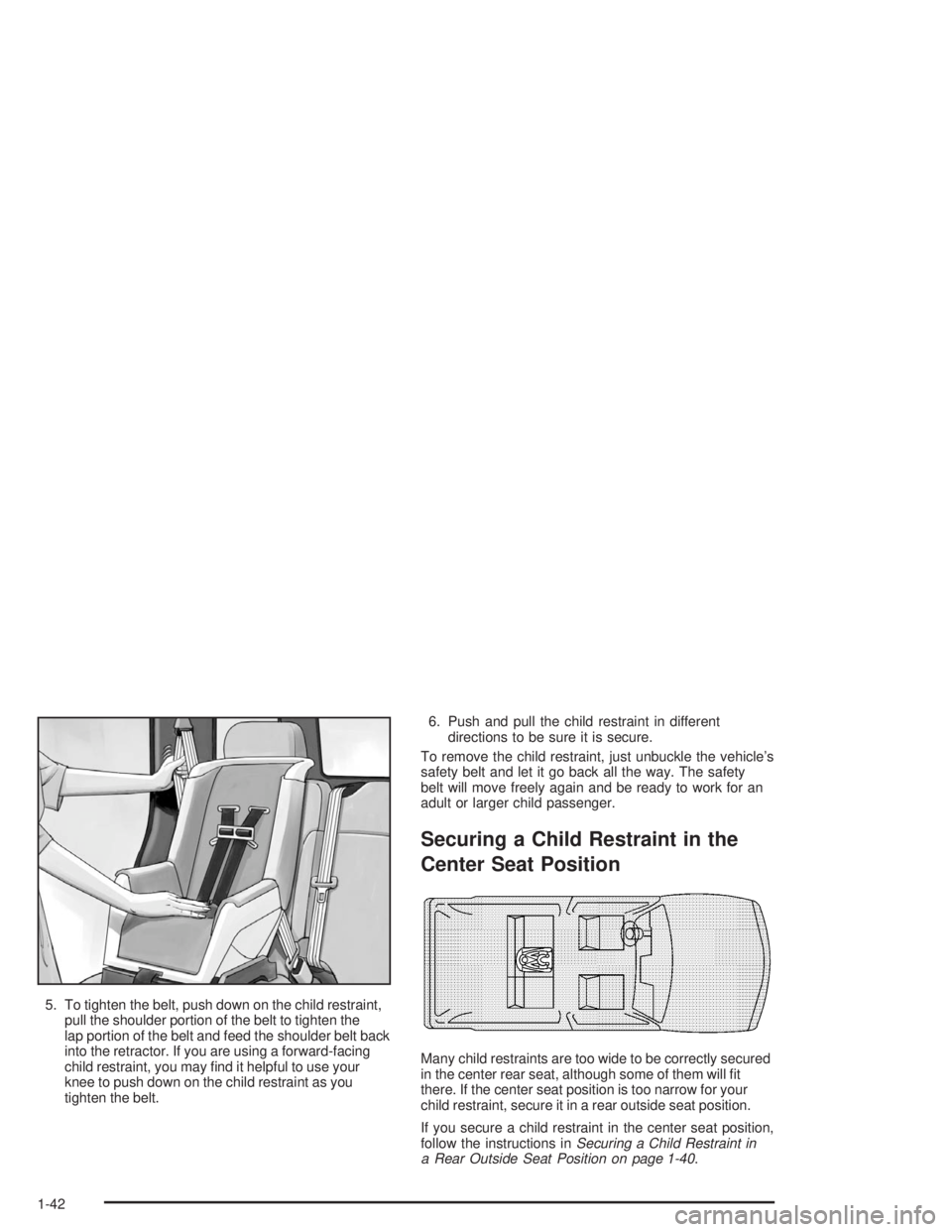
5. To tighten the belt, push down on the child restraint,
pull the shoulder portion of the belt to tighten the
lap portion of the belt and feed the shoulder belt back
into the retractor. If you are using a forward-facing
child restraint, you may �nd it helpful to use your
knee to push down on the child restraint as you
tighten the belt.6. Push and pull the child restraint in different
directions to be sure it is secure.
To remove the child restraint, just unbuckle the vehicle’s
safety belt and let it go back all the way. The safety
belt will move freely again and be ready to work for an
adult or larger child passenger.
Securing a Child Restraint in the
Center Seat Position
Many child restraints are too wide to be correctly secured
in the center rear seat, although some of them will �t
there. If the center seat position is too narrow for your
child restraint, secure it in a rear outside seat position.
If you secure a child restraint in the center seat position,
follow the instructions inSecuring a Child Restraint in
a Rear Outside Seat Position on page 1-40.
1-42
Page 49 of 452
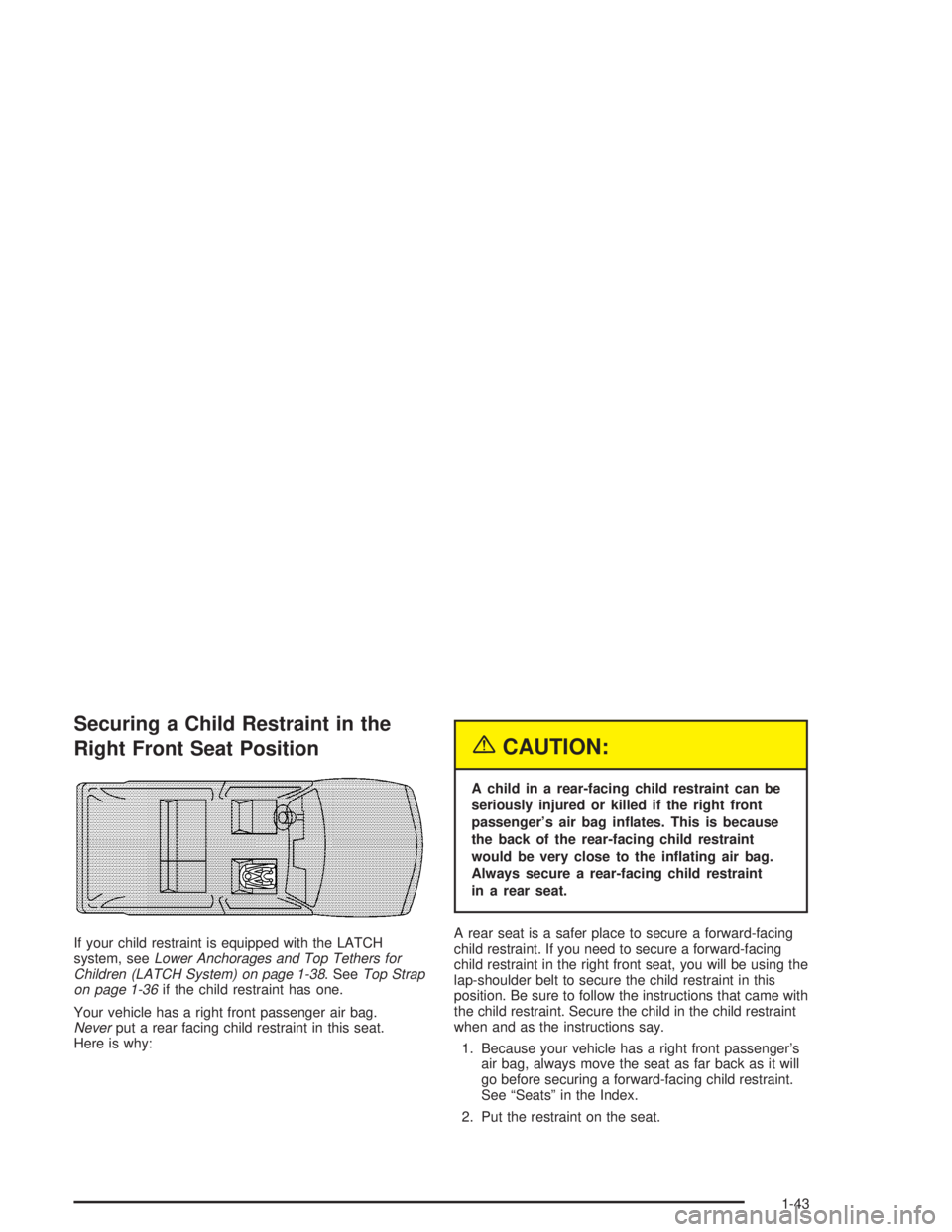
Securing a Child Restraint in the
Right Front Seat Position
If your child restraint is equipped with the LATCH
system, seeLower Anchorages and Top Tethers for
Children (LATCH System) on page 1-38. SeeTop Strap
on page 1-36if the child restraint has one.
Your vehicle has a right front passenger air bag.
Neverput a rear facing child restraint in this seat.
Here is why:
{CAUTION:
A child in a rear-facing child restraint can be
seriously injured or killed if the right front
passenger’s air bag in�ates. This is because
the back of the rear-facing child restraint
would be very close to the in�ating air bag.
Always secure a rear-facing child restraint
in a rear seat.
A rear seat is a safer place to secure a forward-facing
child restraint. If you need to secure a forward-facing
child restraint in the right front seat, you will be using the
lap-shoulder belt to secure the child restraint in this
position. Be sure to follow the instructions that came with
the child restraint. Secure the child in the child restraint
when and as the instructions say.
1. Because your vehicle has a right front passenger’s
air bag, always move the seat as far back as it will
go before securing a forward-facing child restraint.
See “Seats” in the Index.
2. Put the restraint on the seat.
1-43
Page 50 of 452
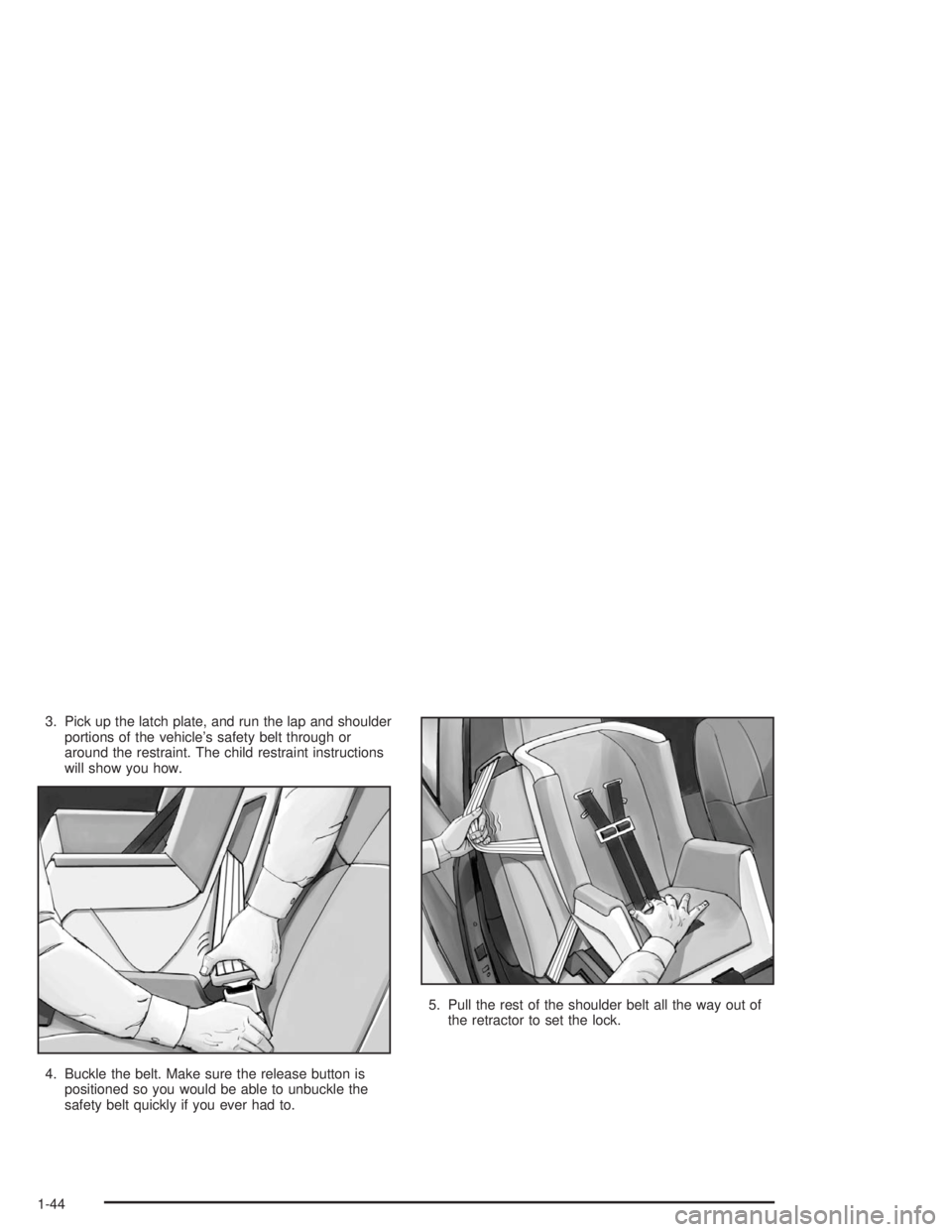
3. Pick up the latch plate, and run the lap and shoulder
portions of the vehicle’s safety belt through or
around the restraint. The child restraint instructions
will show you how.
4. Buckle the belt. Make sure the release button is
positioned so you would be able to unbuckle the
safety belt quickly if you ever had to.5. Pull the rest of the shoulder belt all the way out of
the retractor to set the lock.
1-44